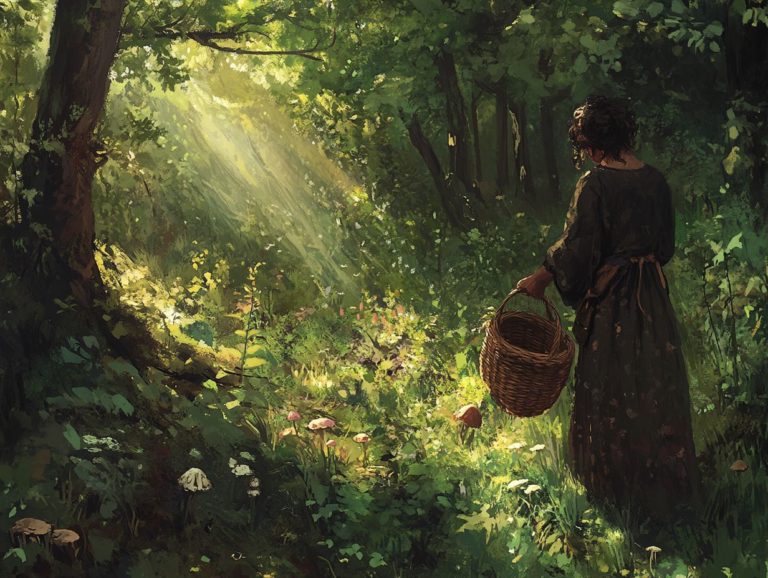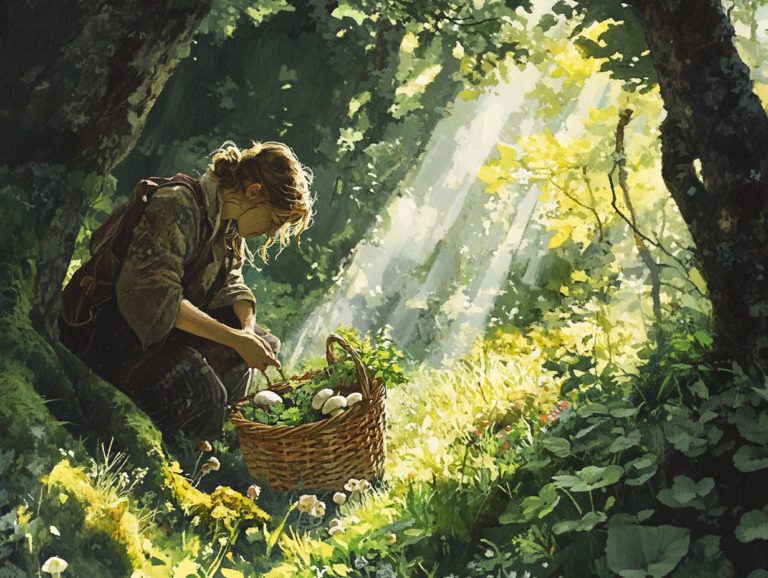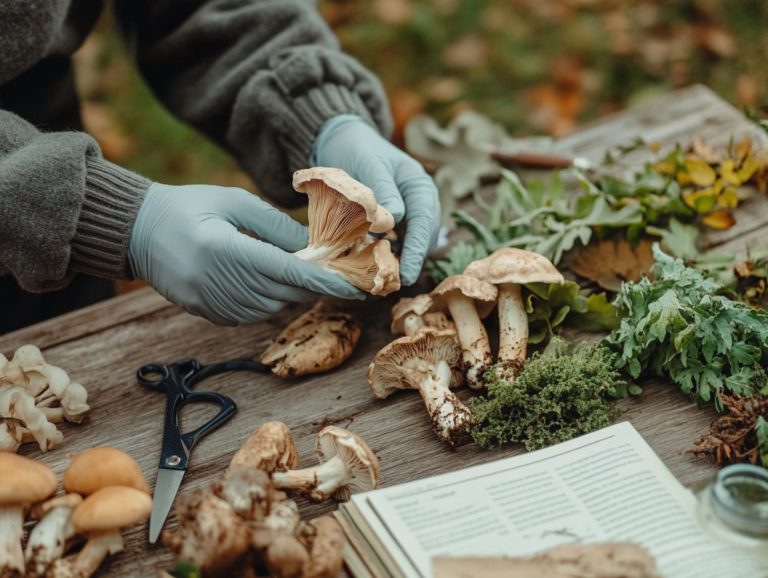How Do Foraging Practices Vary by Region?
Foraging, the timeless art of gathering wild food, transcends mere sustenance. It embodies cultural heritage and shows how we live in harmony with nature.
This exploration delves into the diverse ways foraging manifests in tropical, temperate, and Arctic regions. It reveals the unique practices that have developed in each climate.
You’ll uncover the intricate relationship between people and land through the lens of foraging traditions, inviting you to appreciate this rich tapestry of human connection to nature.
Contents
- Key Takeaways:
- Foraging Practices in Different Regions
- Factors Influencing Foraging Practices
- Impact of Foraging Practices on Ecosystems
- Future of Foraging Practices
- Frequently Asked Questions
- How Do Foraging Practices Vary by Region?
- What types of food are commonly foraged in different regions?
- How do foraging practices differ between rural and urban regions?
- Do different regions have specific foraging seasons?
- Are there any cultural or religious reasons for foraging practices in certain regions?
- How do foraging practices impact the environment in different regions?
Key Takeaways:
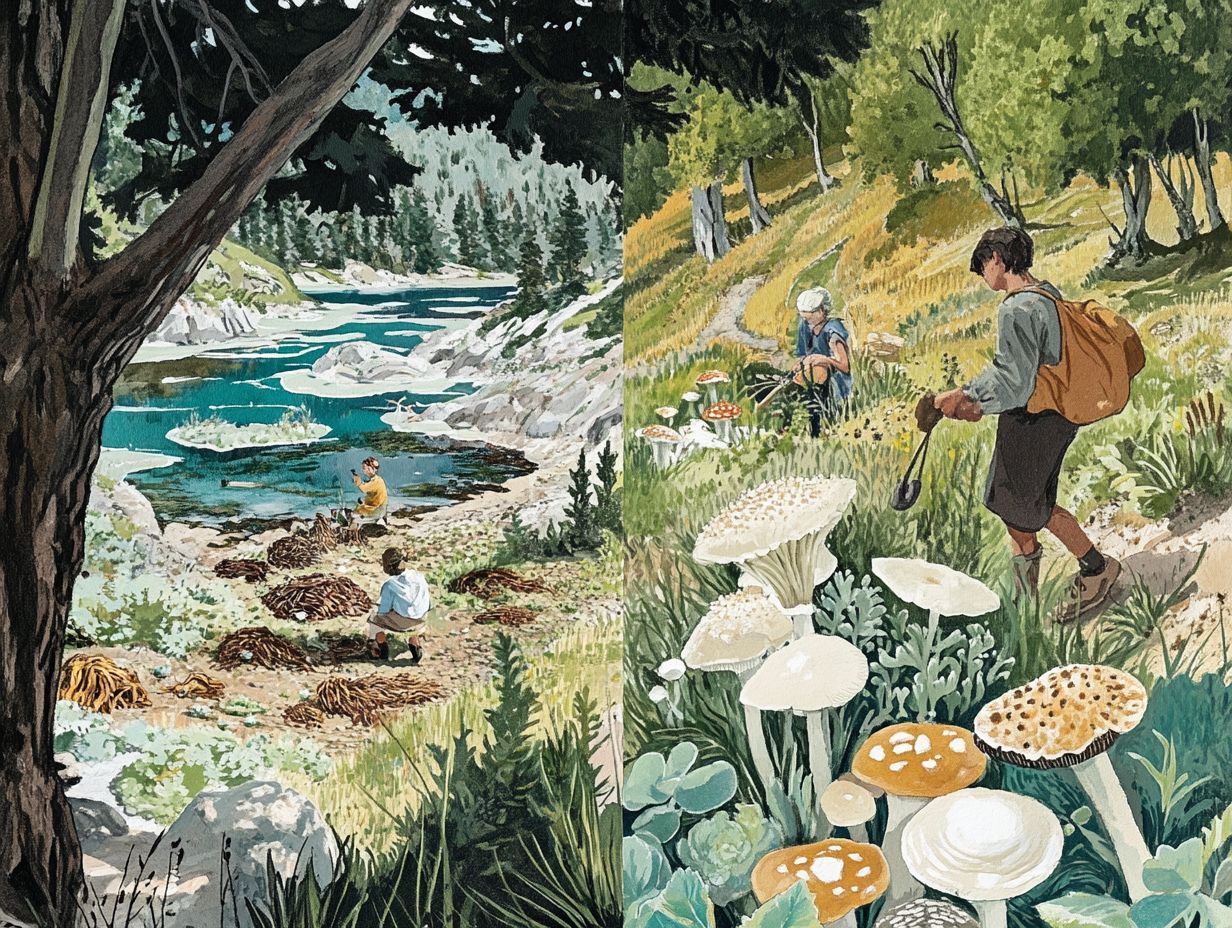
- Foraging techniques and resources vary greatly across different regions, with factors like climate, environment, plant identification, and culture playing a significant role.
- Foraging practices can have both positive and negative impacts on biodiversity and ecological health, making sustainable and responsible foraging methods crucial for preserving the environment.
- As the world continues to evolve, it is important to consider the future of foraging practices, alongside traditional practices, and prioritize sustainability efforts to ensure the longevity of this important practice.
Defining Foraging and its Importance
Foraging, the art of gathering wild food from nature, is not just a trendy pastime; it s vital for your health and the sustainability of our food systems. It contributes to biodiversity and conservation efforts, drawing on ancient indigenous knowledge and community traditions that highlight the importance of ecological health and protecting ancestral territories.
By reconnecting with local flora, you enable yourself to appreciate the intricate relationships within ecosystems, fostering a culture of environmental awareness and environmental stewardship.
In many cultures, foraging is not just survival it’s a thrilling adventure that connects us deeply to the land. This pursuit provides an array of fresh, nutrient-dense foods while playing a crucial role in preserving cultural heritage and traditional diets, and connecting with food culture.
When you engage in foraging, you not only support local economies and sustainable farming practices but also help mitigate the negative impacts of industrial agriculture. This practice encourages mindful consumption, as you learn to respect seasonal cycles and local biodiversity, ultimately benefiting both your community and the ecosystems around you through enhanced awareness and sustainable habits.
Foraging Practices in Different Regions
Foraging practices differ markedly from one region to another, shaped by local flora and the seasonal availability of wild foods. In biodiverse areas such as the Great Lakes region, the unique environmental conditions play a crucial role in determining the diversity of edible plants you might encounter. To understand more about these practices, explore the cultural practices surrounding foraging, which range from luscious wild berries to sought-after mushrooms.
The foraging methods used by local communities are tailored to these specific conditions, reflecting a deep connection to the land and its offerings.
Foraging in Tropical Regions
In tropical regions, foraging opens up a world of edible plants, fruits, and herbs that flourish in warm climates, creating a profound connection between you and the surrounding ecosystem, highlighting the impact of natural cycles.
This vibrant practice not only nourishes local communities but also highlights the vital importance of preserving biodiversity. Community organizations are essential advocates for sustainable foraging techniques, ensuring that traditional knowledge and unique edible species like wild cassava or jungle fruits are both celebrated and safeguarded.
These groups often host workshops and educational events that enable you to engage sustainably with your environment, nurturing a respect for local traditions. By promoting ethical harvesting methods, they help maintain the delicate balance of these tropical ecosystems, encouraging a harmonious relationship between you and nature.
Foraging in Temperate Regions
Temperate regions offer a remarkable variety of wild food options. Foraging helps you learn more about nature and discover an array of herbs, nuts, and berries.
If you find yourself captivated by nature’s bounty, spring presents wild greens like dandelions and purslane, which add nutritious flair to your meals. As the summer sun intensifies, luscious berries such as blackberries and raspberries beckon from brambles along hiking trails. Their vibrant sweetness is irresistible!
When fall arrives, the harvest of acorns and hickory nuts becomes crucial for sustainable practices. These not only support your nourishment but also help local ecosystems thrive.
By embracing mindful foraging techniques and using foraging tools, you can connect more deeply with nature. This highlights the importance of taking care of our environment a key aspect of preserving the richness of diverse habitats.
Foraging in Arctic Regions

In the Arctic regions, your foraging practices draw deeply from indigenous knowledge and traditional ecological knowledge. This wisdom helps you and your community navigate the unique challenges posed by the harsh climate and limited biodiversity.
You identify and harvest a variety of edible plants, including wild berries, seaweed, and roots. These are essential for sustenance. You often employ traditional techniques, adapting them to your specific environment. This ensures your practices remain sustainable and respectful of ecological health.
Use seasonal calendars to find the best foraging times. This enables efficient food gathering while preserving the delicate balance of local ecosystems. The resilience of these food systems showcases your tenacity and reflects a deep commitment to preserving heritage for future generations.
Factors Influencing Foraging Practices
A multitude of factors influences your foraging practices. These include environmental conditions, cultural traditions, and societal norms. Each plays a crucial role in shaping local biodiversity and conservation efforts.
Environmental Factors
Environmental factors like soil degradation and the encroachment of invasive species impact the availability and diversity of foraging options. These present significant challenges to the sustainability of local ecosystems.
The competition that invasive species create for native plants disrupts established relationships within the food web. As biodiversity declines, essential species that support soil health may also wane, worsening the existing problems.
Foragers who depend on specific plant and animal species find their options limited. This complicates efforts to sustain their practices and underscores the importance of food safety.
Understanding these connections is crucial for anyone involved in environmental management and conservation. It highlights the need to maintain healthy ecosystems for future generations.
Cultural and Societal Factors
Cultural and societal factors are pivotal in shaping foraging practices. Local traditions and indigenous knowledge inform your methods and ethics around gathering wild foods.
These practices are woven into the fabric of community identity. Sharing techniques and experiences fosters belonging and collective responsibility. Community involvement strengthens social bonds and nurtures a shared understanding of sustainable practices that honor the environment.
Educational initiatives emphasize the significance of biodiversity and ethical wild resource gathering. By embracing these cultural elements in your foraging journey, you can deepen your connection with your surroundings. This ensures that you pass on invaluable knowledge and appreciation for nature to future generations.
Master these skills now to enjoy nature s gifts for years to come! Join a local foraging group to start your adventure today!
Impact of Foraging Practices on Ecosystems
Foraging practices have the potential to significantly affect ecosystems, having both positive and negative influences. The impact on biodiversity and the overall health of local environments largely depends on the methods and values you adopt as a forager.
Positive and Negative Effects
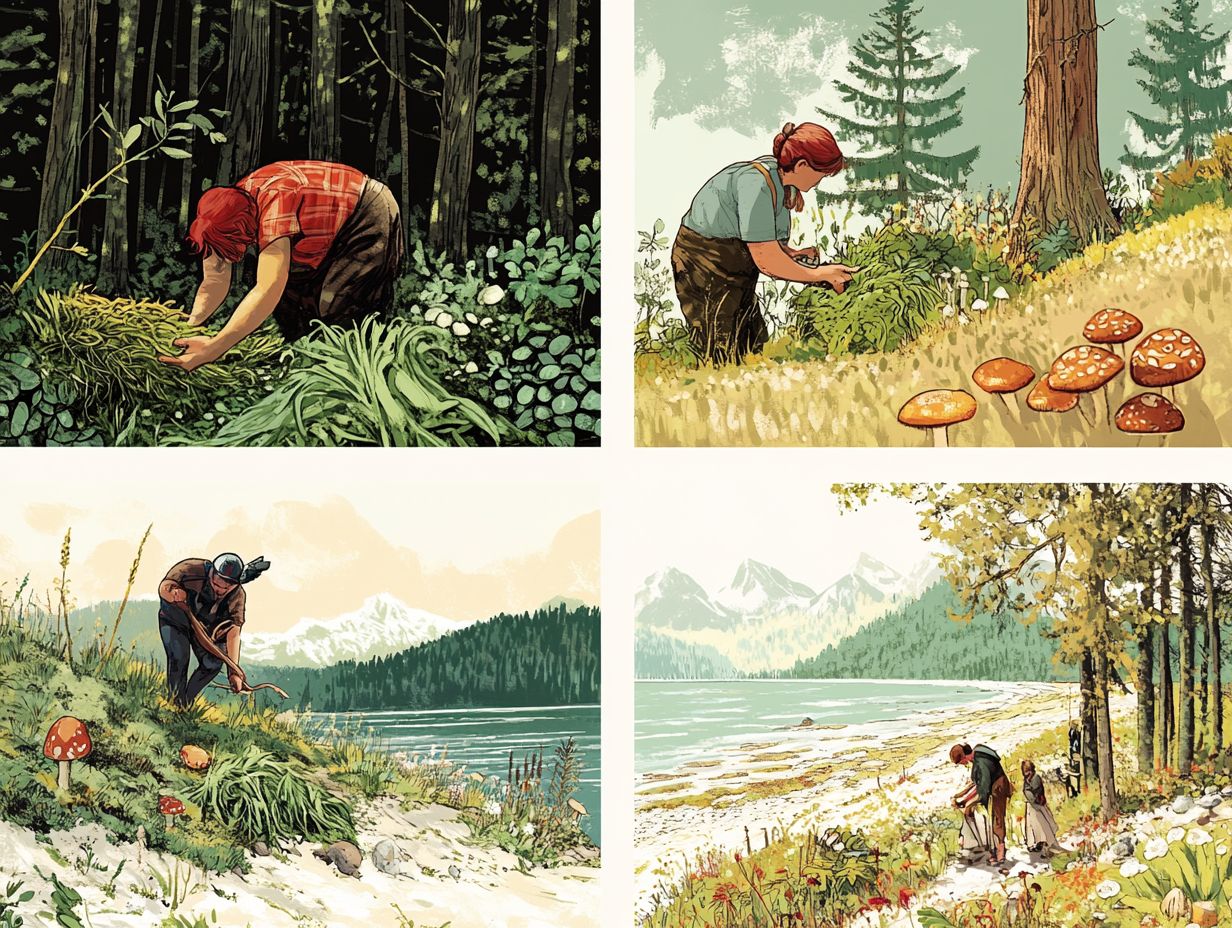
Foraging brings exciting benefits that boost biodiversity and strengthen community ties. However, negative impacts can arise from unsustainable practices that threaten local ecosystems.
Research from the North American Wild Foods Association showcases how responsible foraging can preserve native plant species. When communities engage in foraging, they often develop a vested interest in maintaining the habitats from which they harvest.
Studies from ecological organizations like the Global Forest Coalition reveal that overharvesting certain plants, such as wild ginseng, can lead to significant depletion of populations and disrupt local food webs.
This duality highlights the critical need for sustainable foraging practices. Various conservation groups have successfully implemented guidelines that ensure ecological balance, allowing communities to enjoy wild resources while protecting the environment.
Future of Foraging Practices
The future of foraging practices depends on your commitment to sustainability and preservation. Emphasizing environmental stewardship and ethical gathering is essential for safeguarding local ecosystems.
By prioritizing these principles, you play a pivotal role in ensuring that foraging remains a responsible and enriching practice for generations to come.
Sustainability and Preservation Efforts
Sustainability and preservation efforts are vital in foraging. Community organizations and responsible practices aim to minimize environmental impact.
Utilizing tools like field guides, mobile apps, and participating in foraging workshops can deepen your understanding of which plants thrive and which ones are endangered. Community organizations play a crucial role by hosting local foraging events that educate attendees and raise awareness about the delicate balance within local ecosystems.
These initiatives often lead to the creation of volunteer clean-up days and monitoring programs. Through collaboration, these organizations enable you to make informed choices, ensuring that foraging remains a sustainable practice for generations to come.
Frequently Asked Questions
How Do Foraging Practices Vary by Region?
Foraging practices vary greatly depending on the region, influenced by different climates, landscapes, and cultural traditions, as outlined in understanding regional foraging techniques.
What types of food are commonly foraged in different regions?
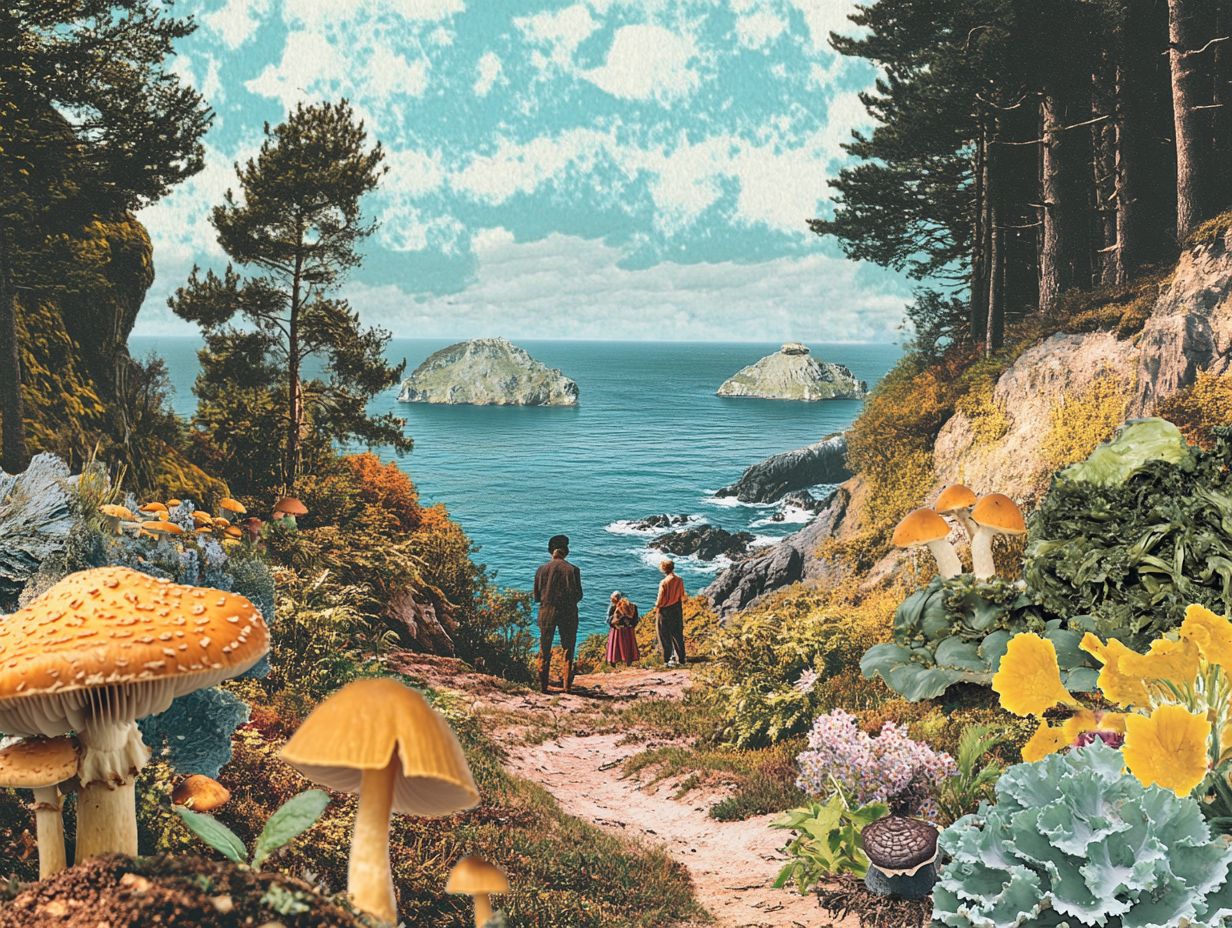
In coastal regions, seafood and seaweed are often foraged, while in mountainous areas, berries and wild greens are more common.
How do foraging practices differ between rural and urban regions?
In rural areas, foraging is often a way of life and a means of sustenance, while in urban areas it is more of a hobby or pastime.
Do different regions have specific foraging seasons?
Yes, foraging seasons can vary greatly by region. For example, spring may be the best time to forage for mushrooms in one area, while autumn may be prime for wild berries in another.
Are there any cultural or religious reasons for foraging practices in certain regions?
Yes, foraging practices may be tied to cultural or religious traditions. Some indigenous communities have specific rituals for gathering certain foods.
How do foraging practices impact the environment in different regions?
In some regions, foraging can negatively impact the environment if not done sustainably. However, in other areas, foraging can help preserve biodiversity and traditional knowledge.
Join a local foraging group today to get involved and make a positive impact!


